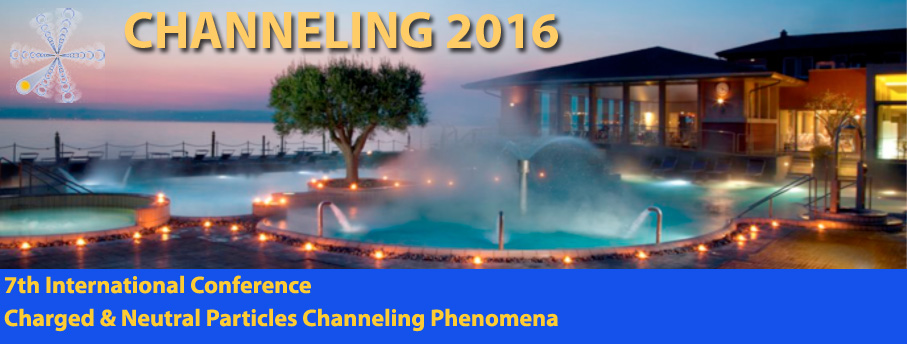Speaker
Dr
Vladimir Zvorykin
(P.N. Lebedev Physical Institute of Russian Academy of Sciences)
Description
A high-energy (up to 3 kJ in ns pulses) UV radiation (λ=248 nm) of KrF laser is successfully used in the Inertial Confinement Fusion (ICF) [1]. For ~ 1GW peak power in numerous angular multiplexed beams, nonlinear effects were not observed yet under propagation along ~100-m air path and in transmissive optics. TW peak power of sub-ps UV pulses at Ti:Sapphire/KrF GARPUN-MTW laser facility exceeds a critical power Pcr ≈ 100 MW and the laser beam becomes unstable in respect of Kerr self-focusing, and multiple filamentation arises [2]. It has a great impact on saturation of short pulse energy and optics degradation [3]. Therefore, suppression of beam filamentation is of high priority for the facility operation itself. On the other hand, filamented UV laser beam produces a bunch of partially ionized narrow plasma channels ranging to more than hundred meters in atmospheric air with a potential application for virtual sliding-mode MW waveguides [4]. Those might require regularizing of occasionally distributed filaments in the laser beam. The performed experiments at GARPUN-MTW laser purposed both these objectives.
To suppress multiple filamentation we transferred 1-ps, 0.1-J linearly polarized output radiation through a 2.5-m length cell filled with Xe gas at pressure up to 1 atm. KrF radiation has a 2-photon resonance with Xe 6p [1/2]0 state, which causes unusual large negative nonlinear refractive index at KrF laser wavelength [5]. This should defocus high-intensity filaments in contrary with a common Kerr self-focusing in air and laser windows. As a result, in present experiments filaments with local peak intensity of ~ 0.2 TW/cm2, 200-fold higher than the average one, were homogenized to significantly lower intensity. Total energy loss in the cell of 20% was measured. Filamentation mitigation had a minor effect on the laser beam focusing. Remarkably, UV filaments in Xe produced a narrow-angle coherent cone emission at 828-nm wavelength. In a far-field zone, the IR light pattern looked like thin-wall rings surrounding individual filaments. Stimulated hyper-Raman scattering and amplified spontaneous emission at 6p [1/2]_0 → 6s [3/2]^0_1 transition of atomic Xe [6] may explain this emission.
Amplitude masks with multiple apertures of different configurations were introduced in the beam and UV radiation distribution was measured behind the masks. A transformation from UV light diffraction patterns into regularized filaments structures was clearly observed with increasing the propagation distance.
The research was supported by the RSF Project No. 14-12-00194 and by the RFBR Projects No. 15-02-09410 and 14-22-02021.
References
1. S. Obenschain, R. Lehmberg, D. Kehne, et al., Appl. Opt. 54 (2015) F103.
2. V.D. Zvorykin, A.A. Ionin, A.O. Levchenko, et al., NIMB 355 (2015) 227.
3. V.D. Zvorykin, A.A. Ionin, A.O. Levchenko, et al., Quantum Electron. 44 (2014) 431.
4. V.D. Zvorykin, A.A. Ionin, A.O. Levchenko, et al., Appl. Opt. 53 (2014) I32.
5. R.H. Lehmberg, C.J. Pawley, A.V. Deniz, et al. Opt. Commun., 78 (1995) 78.
6. A. Tunnermann, K. Mossavi, B. Wellegehausen, Phys. Rev. A, 46 (1992) 2707.
Summary
Nonlinear effects under propagation of TW power sub-ps UV pulses of KrF laser along the amplification tract in air and transmissive laser optics were studied at Ti:Sapphire/KrF GARPUN-MTW laser facility. Suppression of multiple filamentation of a supercritical laser beam was demonstrated in Xe, which has unusual large negative nonlinear refractive index at KrF laser wavelength. A narrow-angle coherent cone emission at 828-nm wavelength was observed around UV filaments in Xe. Regularizing of occasionally distributed filaments was achieved by means of amplitude masks.
Primary author
Dr
Vladimir Zvorykin
(P.N. Lebedev Physical Institute of Russian Academy of Sciences)
Co-authors
Mr
Alexei Shutov
(P.N. Lebedev Physical Institute)
Prof.
Andrei Ionin
(P.N. Lebedev Physical Institute)
Ms
Daria Mokrousova
(P.N. Lebedev Physical Institute)
Ms
Elena Sunchugasheva
(P.N. Lebedev Physical Institute)
Dr
Igor' Smetanin
(P.N. Lebedev Physical Institute)
Dr
Leonid Seleznev
(P.N. Lebedev Physical Institute)
Dr
Nikolai Ustinovskii
(P.N. Lebedev Physical Institute)

